This male, photographed near a mountain stream three days ago, might have been my most prolific posing kingfisher ever. Too bad he wasn’t in a more attractive setting.
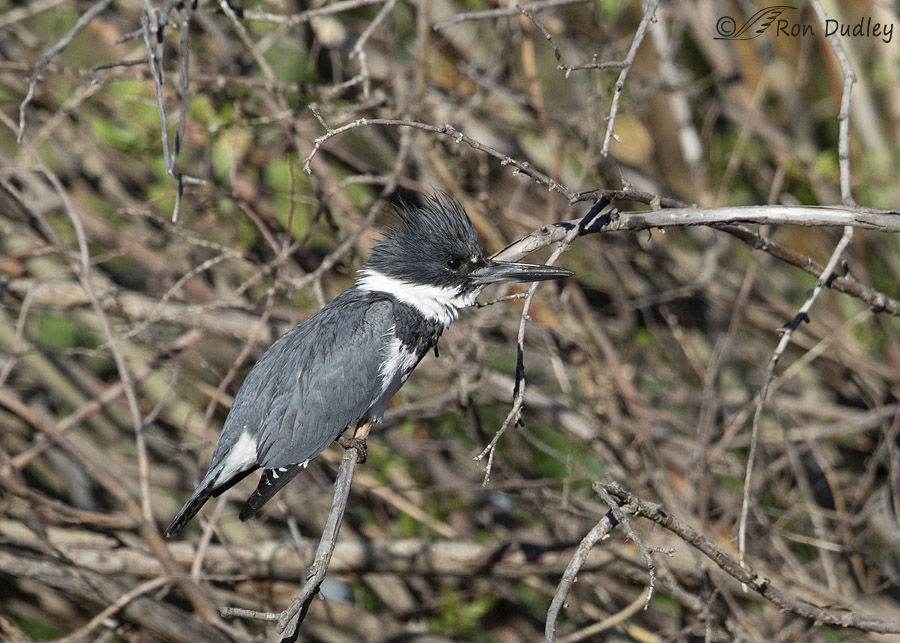
1/5000, f/6.3, ISO 800, Canon 7D Mark II, Canon EF 500mm f/4L IS II USM + EF 1.4 III Extender, not baited, set up or called in
It’s the same bird I posted in a cluttered setting several days ago. This time he’s on a different perch but the clutter’s still there. He wasn’t particularly close and the branches and twigs are so busy I almost didn’t even fire my shutter but my photographer’s instincts kicked in when he began to perform.
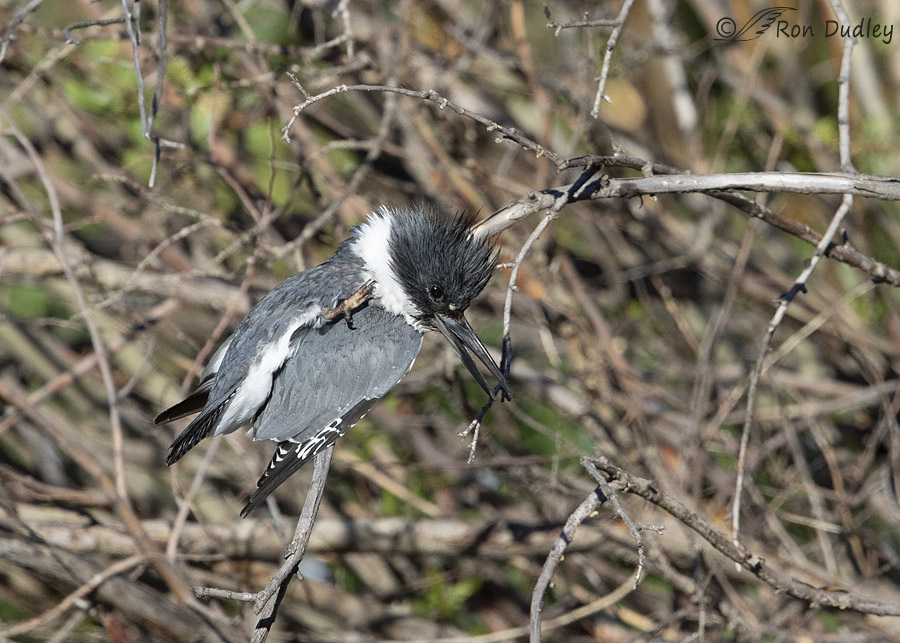
1/4000, f/6.3, ISO 800, Canon 7D Mark II, Canon EF 500mm f/4L IS II USM + EF 1.4 III Extender, not baited, set up or called in
It all started with an itchy neck.
It’s amazing that he could reach that spot on his neck with his feet attached to such stubby legs but he did it. His technique was to drop his right wing, wrap his short leg over the top of it and then lean in the direction of his foot with his neck and head to make it a shorter distance to reach.
That itch and resulting scratch set a series of posing events into motion including…
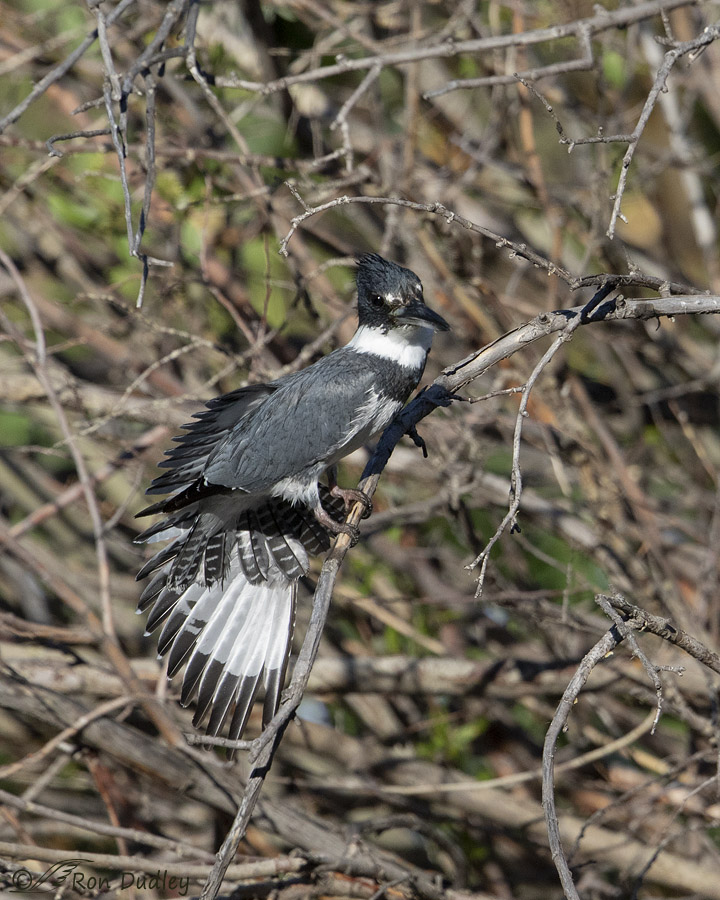
1/4000, f/6.3, ISO 800, Canon 7D Mark II, Canon EF 500mm f/4L IS II USM + EF 1.4 III Extender, not baited, set up or called in
a languorous downward stretch of his left wing. He turned his head at an angle that very nearly prevented me from getting any light in his eye but this is one of the shots where I did manage to get a catch light. He never did stretch his right wing downward.
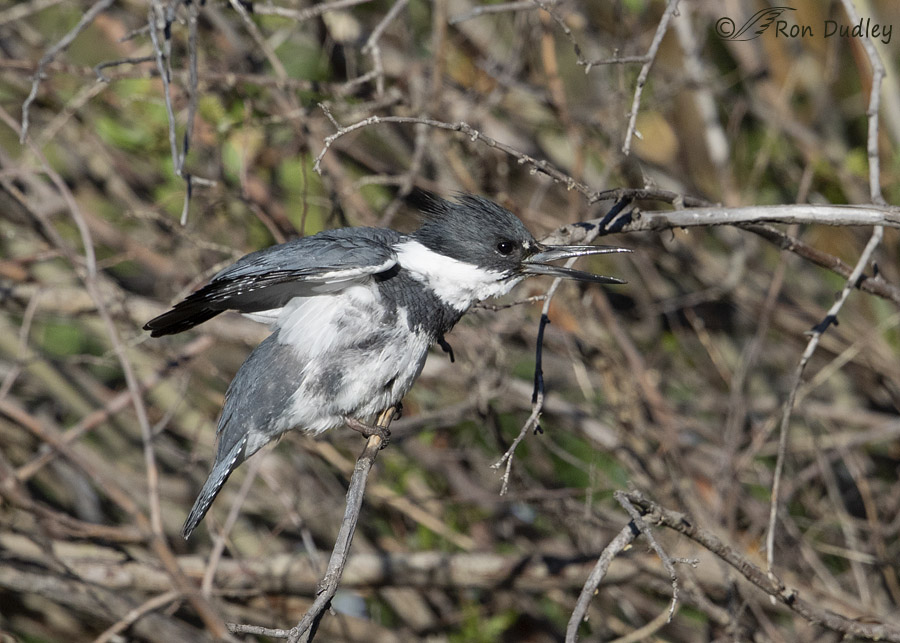
1/5000, f/6.3, ISO 800, Canon 7D Mark II, Canon EF 500mm f/4L IS II USM + EF 1.4 III Extender, not baited, set up or called in
Next came a bilateral upward wing stretch. It was another slow stretch – this is only the beginning of it.
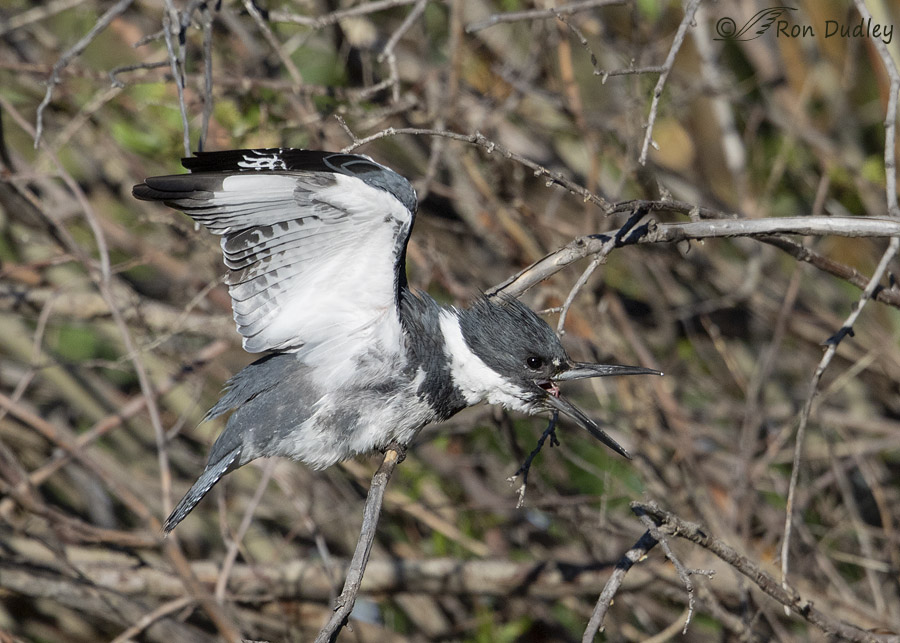
1/5000, f/6.3, ISO 800, Canon 7D Mark II, Canon EF 500mm f/4L IS II USM + EF 1.4 III Extender, not baited, set up or called in
Eventually he really got into it, including opening his beak about as wide as he possibly could. It really didn’t look like a yawn to me but I can’t say conclusively that it wasn’t.
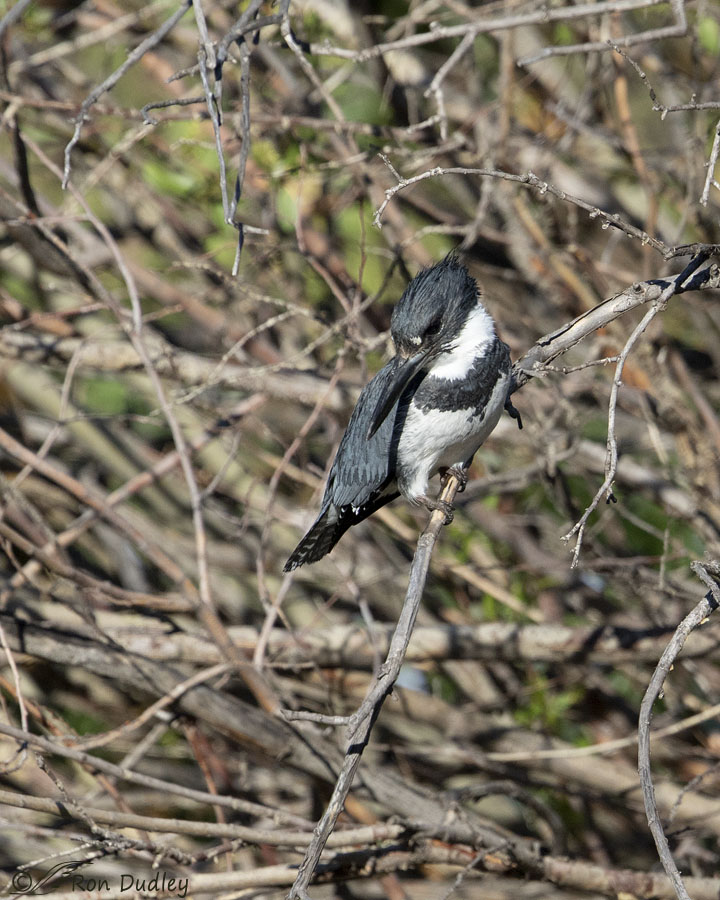
1/4000, f/6.3, ISO 800, Canon 7D Mark II, Canon EF 500mm f/4L IS II USM + EF 1.4 III Extender, not baited, set up or called in
But his performance was interrupted when he spotted a fish in the water below and behind him. In a flash he…
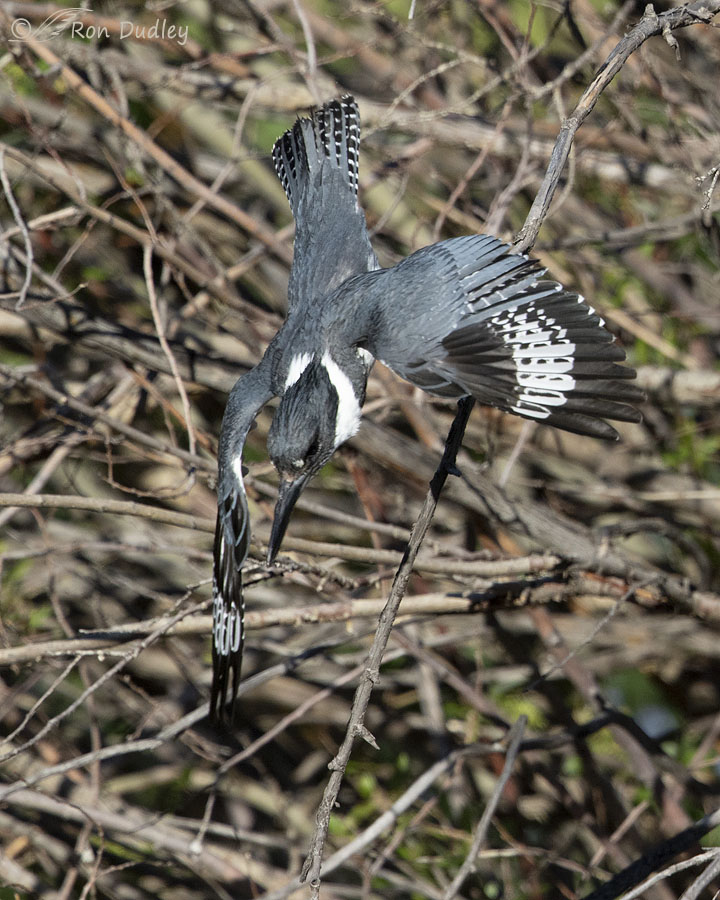
1/4000, f/6.3, ISO 800, Canon 7D Mark II, Canon EF 500mm f/4L IS II USM + EF 1.4 III Extender, not baited, set up or called in
dove on it. I was hugely disappointed to not get any light in his eye because I really like this flight posture and angle.
As far as I could tell, he missed the fish.
Ron


What didn’t that bird do for you???👏✌️👍
Well for starters he didn’t catch a fish and eat it right in front of me. Not complaining though…
In my limited experience attempting to photograph these quick, sneaky buggers ANY pose is interesting. These are just exceptional.
“these quick, sneaky buggers”
Ha, well said, Jim. Your experience may be limited and it’s certainly typical.
I loved these. My guess is that he’s part of the KWCR (Kingfishers Who Confound Ron.) His task (they make sure members are willing to do whatever it takes) was to pose for you. He had to choose a really jumbled background AND pose in awkward positions.
Thanks, Arwen. The group is actually called KWCE (substitute ‘Everyone’ for Ron) 🙂
Thank you for some timely fun today. It is much needed today (our curfew started at 1 p.m. this afternoon in select areas and will start at 4, city-wide).
Damn, I’m sorry to hear that, Marty. Things have calmed down here, for now at least.
Although we have Belted Kingfishers here, I don’t think I will ever see all those poses. It’s pretty much flying or sitting dead still.
I may never see them again, Lyle. At least not from the same bird in such a short time.
Another great series.
And I couldn’t help thinking you missed the catch light in the final shot – and he missed the catch.
“you missed the catch light in the final shot”
The final TWO shots, EC. I noticed that too.
Wonderful photos, as always. This is still a species I have yet to get a good photo of. I have photos of perches and distant blobs, but nothing worth keeping. I’m sure their chatter as they fly away is their laughter and saying “you missed again.”
As for head-scratching over the wing, that’s what all Belted Kingfishers will do. All birds of a particular species are either “over-the-wing” or “under-the-wing” head/neck scratchers. The pattern is consistent throughout the species. In general, predominately ground-dwelling birds head-scratch under-the-wing and those perched in trees are over-the-wing, but there are many exceptions. If you are on the ground it is usually easier to raise the wing and on a perch, better balance is maintained by going over-wing.
Thanks, Dan. Interesting info. I wonder if each group of birds could scratch either way in a pinch. My guess is yes, at least most of them.
Good question. I don’t really know because this seems to be a very fixed behavior within a species. It’s not the kind of behavior that one thinks of as innate, but as far as I can tell there is no variation within a species. If that’s the case, head-scratching differently from the norm may not be possible or only with great difficulty. It happens so quickly and I usually don’t pay enough attention to have seen any possible variation.
Thank you Dan.
That is truly fascinating. I knew that birds could be right or left footed but hadn’t thought about the over/under wing scratching. Learning all the time. Which has to be a good thing (though I do wish I could retain more of what I learn.
This is another interesting topic that still needs a lot of investigation. Head-scratching pattern is consistent within a species but footedness is not. In general, most parrots are left-footed, but in some birds it varies from individual to individual. In many passerines, the number of right-footed individuals is nearly equal to left-footed individuals. But some experiments show that right-footed passerines can escape more quickly than left-footed individuals. With equal number of left-footed birds, there must be some advantage to being left-footed as well, but no one is quite sure what that is. Just another fascinating topic of studying birds.
I am happy you decided to take photos despite the clutter. I stop what ever I am doing and watch birds preen, stretch and bathe. For some reason I find it both fascinating and a graceful ballet. As I type this my bird is on my shoulder preening his wings and tail, I love the sound when they rezip the barbs on the long feathers.
On the topic of gofer snakes, on April 22 when we had a colder morning, my trip to BRMBR included helping about a dozen young gofer snakes off the road to the auto loop. They were all cold and lethargic, easy to pick up and move to the rocks or grass off the road. I say a number of snakes that had been run over. I didn’t stop to take photos, I was in the middle of the road and did not want to get hit while photographing.
I’m glad you were there to come to the rescue of those snakes, April. Sadly I see far more road killed gopher snakes than living ones.
As a fellow reptile-lover, I thank you for helping all those snakes April. You definitely made a difference in a dozen lives.
Amazing! Wonderful shots of an animated male that obviously loved posing for you!! VBG!
Great shots Ron, I’m envious of your posing Kingfisher.
I think he was the most animated kingfisher I’ve ever photographed, Dick. I’m glad I was there to take advantage of the opportunity.
Stunning series Ron! Thanks for sharing!
Thanks, Charlotte.
A fun fact from the Audubon society that was first thing on my news feed.
Radar studies show an American Kestrel migrant at altitudes greater than 2,000 feet above the ground, where they’re unlikely to be seen.
And then your beautiful picture of this little guy😁 I’ve only been lucky enough to see one for a split second ❗️
Don’t feel too bad, Diana – split second views of kingfishers are the rule rather than the exception.
WOW! Just WOW! What a wonderful series and what a beautiful bird!
As I was going through these lovely images, the thought occurred to me that these guys are birds of prey, too. They might not grab their prey with their feet, but they’re certainly hunting other creatures vigorously. I’d welcome them into the bird-of-prey fold. Just a random thought this morning. Who knows where it originated? LOL!
Yup, the label “birds of prey” has always been slightly confusing to me, Laura. Nature is seldom easy to pigeon-hole.
These are wonderful, Ron. I especially like the dive shot and his spiky head in the first two. Happy June!
Same to you, Cathy. But I must admit the first of the month mostly means “happy bill paying day” to me… 🙂
I really admired that last ( diving ) shot , what a great shape he made !
I like it for the same reason, Kris. What a dynamic flight posture.
Long lens really helps with these guys and gals. I use a super-zoom bridge camera that requires getting much closer, and as you know these Kingfishers will be gone if they sense you are somewhere close. These are excellent photos Ron. Love the outstretched wings. Have also not seen any snakes of any kind so far and we are no doubt warmer than you are so far this spring.
Thanks, Everett. Kingfishers in this area were really spooky during most of the spring but they’ve settled down a little now and allow a closer approach.
WOW! Wonderful series! 🙂 “Long lens” certainly makes it possible to get up close and personal for the behavior! The “scratch” and “wing stretch not to mention the flight shot have a VBG on my face……. 🙂
1st bullsnake of the season in a tree after eggs – a spruce tree to boot – somewhat unusual…… 😉
Judy, I love my long lens!
I’ve been watching for bull snakes (gopher snakes) in an area where I often see them but so far I haven’t seen any this year.
He really offered you a lot! Your last photo really gives a nice look at the feather markings as does his yawning stretch. Yep…if anything I think he has a slightly more cluttered perch but he still stands out nicely. Such short legs for this bird…makes one wonder why. I’m sure it’s just happenstance but inquiring minds you know 🙂!
“makes one wonder why”
Kathy, I suspect it’s at least partly because they nest in burrows in mud banks. Long legs just wouldn’t work in narrow burrows.